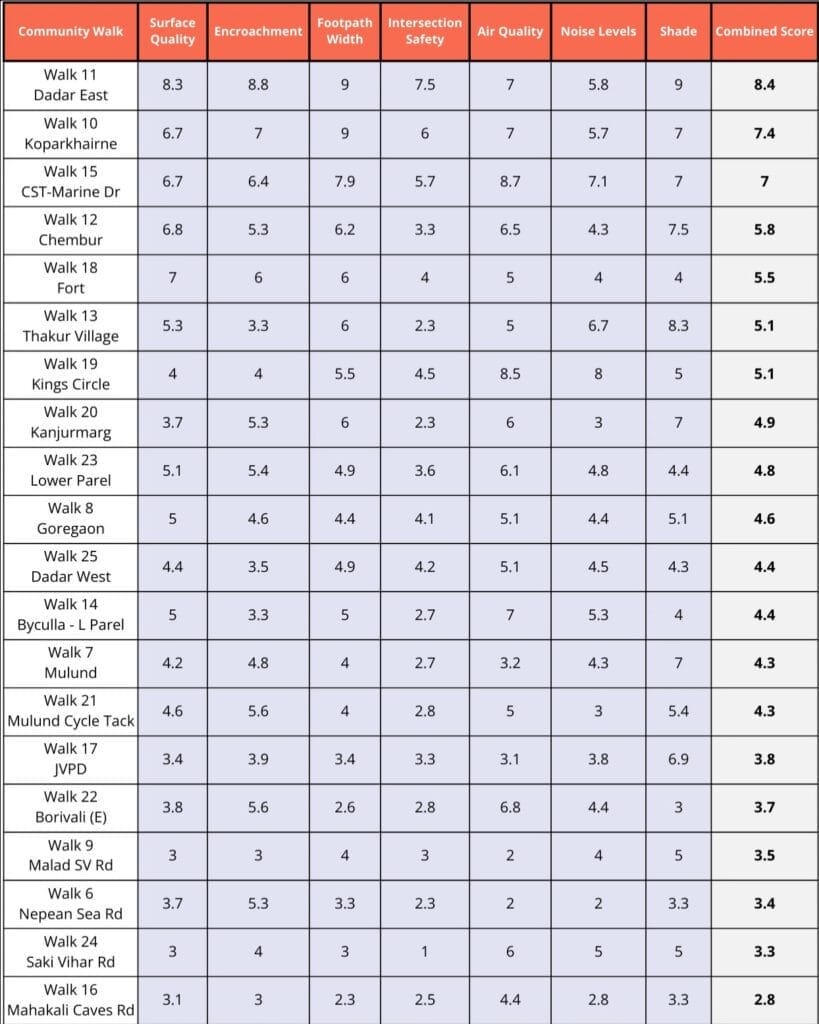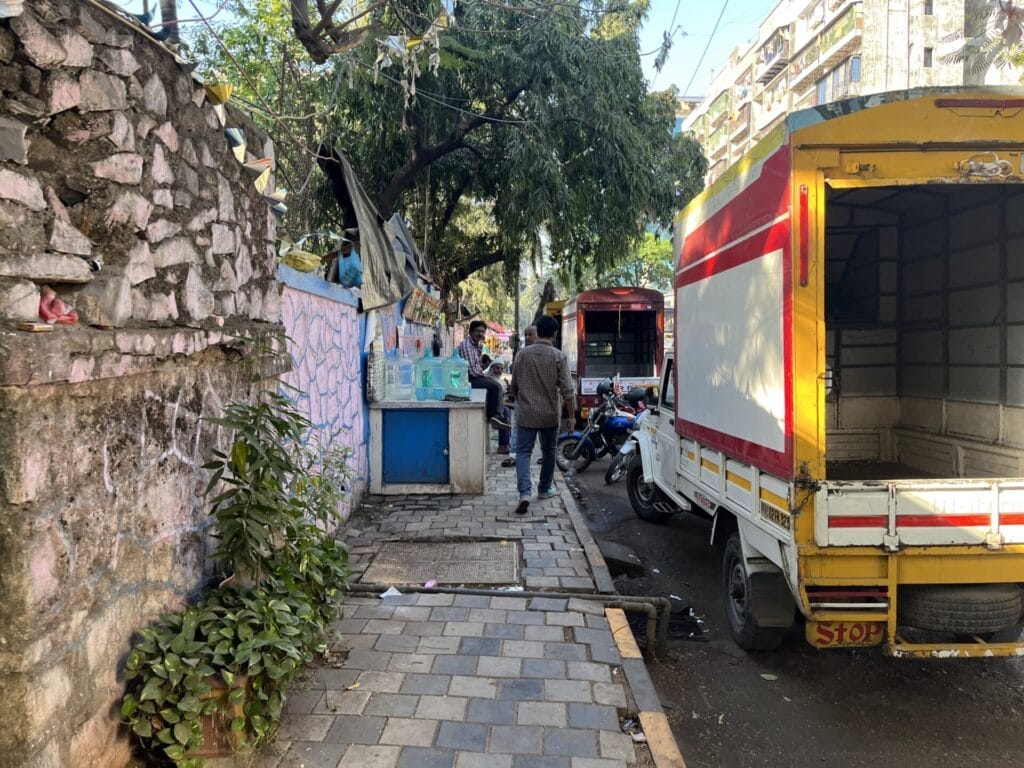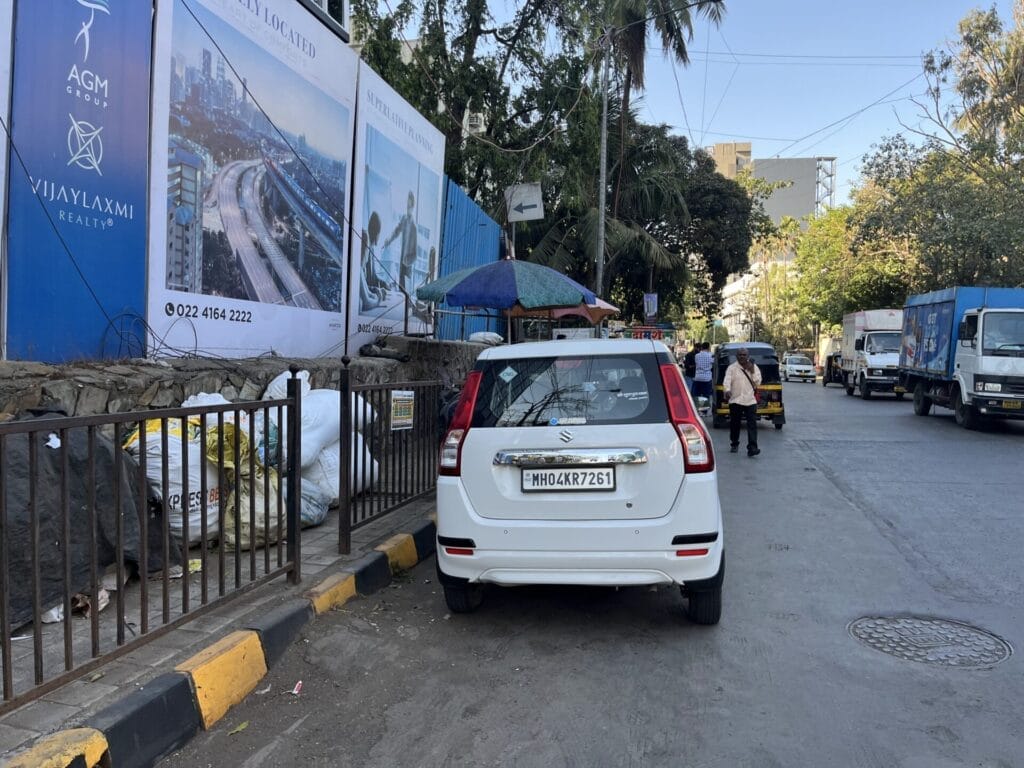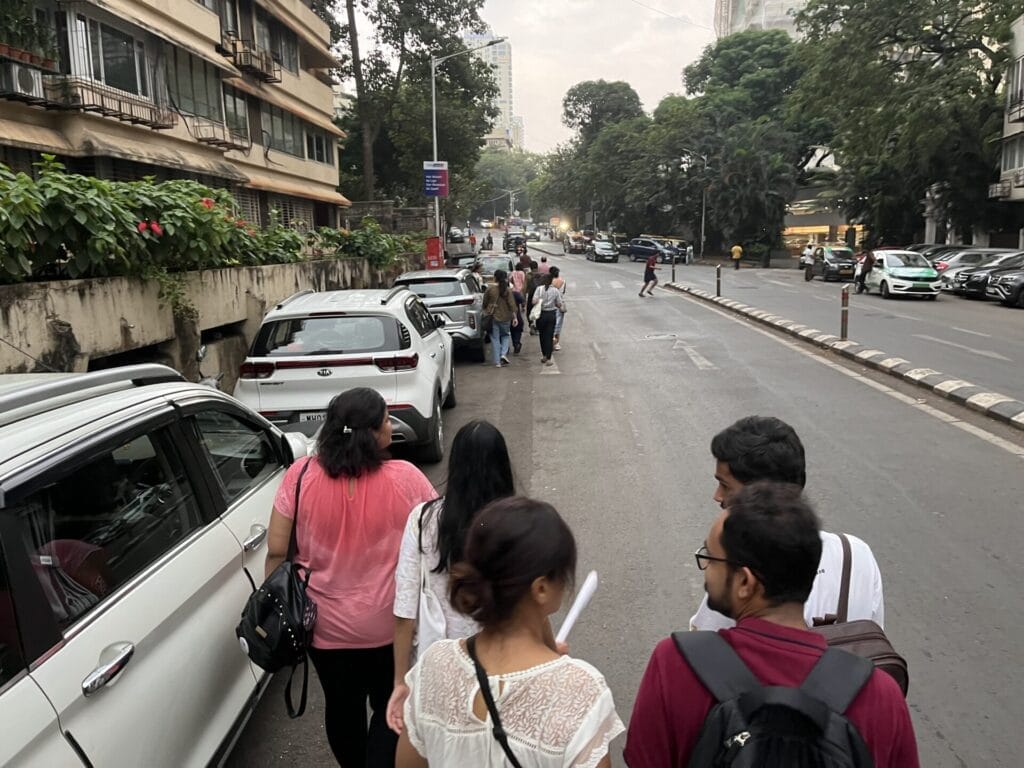Over nine months, we at Walking Project in Mumbai hosted 25 community walks across various neighbourhoods in the city. In groups of 10–15 people, walking across different neighbourhoods, we discussed walkability, educated citizens about the guidelines which dictate the design of walking spaces nationwide, and advocated for urban planning that prioritises walking, among other topics.
One of the key highlights of this initiative was the ranking system we developed for the routes we walked. During each walk, we asked participants to rate their route based on specific walkability criteria. This allowed us to create a ranking of the best and worst routes, quantifying what is often described subjectively as ‘vibes.’
Read more: Walkability: Endless roadblocks force Bandra residents to map their own roads
Determining a walk score is not a novel concept. In fact, the Indian Roads Congress (IRC) guidelines include a detailed section on how to calculate it. We adapted this process, simplifying and modifying it to suit our on-the-go data collection needs. The results offer valuable insights and learning opportunities on Mumbai’s roads.
Walkability: How did we calculate the scores
We asked participants to rate the walk route on seven different characteristics using a simple online form, with a 1–10 scale where a higher score indicates greater satisfaction with the walkway. The criteria were ‘surface quality’, ‘walkway widths,’ ’level of encroachment’, ‘intersection safety’, ‘shade’, ‘air quality’ and ‘noise levels’.
We used a formula to process and combine these discrete scores into a single walk score. Each category was assigned a different weight based on its perceived impact on walkability. ‘Walkway widths’ were given the highest importance, while ‘air quality’ and ‘noise levels’ were considered less critical.

Through our walks, we observed that wide footpaths and the safety they provide immediately enhance the pedestrian experience, even on less maintained or obstructed paths. Ultimately having the space to walk is fundamental for pedestrians. Surface quality and shade are only effective once the space to walk is present. When these factors come together the walking experience is much more comfortable, especially during the peak of summer.
Well-designed intersections that prioritise pedestrian safety and comfort further enhance the walking experience. While lower noise levels and better air quality contribute to a more pleasant environment, they were assigned lower weight because they are secondary to the physical aspects of the built environment.
What were our findings?

Not surprisingly, the Dadar East route, which meandered through tree-lined, adequately wide footpaths and ended in the picturesque, upscale Five Gardens neighbourhood, received the highest rating. Everyone loved this route. In contrast, the route along Mahakali Caves Road was rated the lowest. So, what made these two routes stand out so dramatically?

Merits of the top-rated route
The Dadar route began at the railway station and immediately offered a comfortable 3-metre-wide footpath. Four of us could easily walk side by side without jostling with each other. The path expanded to around nine metres wide near Hindu Colony. Although partially encroached upon by parking, it still provided ample space for comfortable navigation. The detour around Dadar TT Circle was also pleasant, with wide footpaths and smoothly-sloped curbs that made step-on, step-off transitions easy.
While some encroachment was present, it rarely obstructed our walk. The route was well-shaded by trees, noise levels were manageable, and the surface quality was largely impeccable. Accessibility features like tactile paving and wheelchair ramps were also present.
The route’s residential setting helped minimise significant encroachment issues, unlike high footfall areas where hawkers are common. Hawkers here were legally accommodated in kiosks placed at the footpath edges, causing no hindrance. Overall, these footpaths are among the best in the country and rightfully earned the top spot.

Now, let’s compare this with the least-rated route. We started at the Holy Family School in Andheri East, where the footpath was barely two metres wide, despite the road itself being twice as wide as the one in Dadar. The footpath was also elevated three times the prescribed height, posing a challenge for those with weak knees.
Drawbacks of the lowest-rated route
Throughout this route, no footpath met the standard for adequate width. Obstacles such as garbage, portable urinals, hawkers, and bus stops frequently obstructed the path. Intersections were difficult to navigate due to poor design: crossings were often blocked by extended medians, there were no zebra crossings, signage was inadequate, and vehicles frequently stopped where pedestrians needed to cross. This made the environment unpleasant and hazardous.
Read more: Noise, dust and traffic: Coping with redevelopment in neighbourhoods
Although there was some tree cover, the narrow road trapped dust and vehicle exhaust, exposing us to fumes. The footpath surface was often broken. These issues rightfully earned Mahakali Caves Road the lowest ranking.
What do the top five ranked routes have in common? Dadar East, Koparkhairne, Churchgate, Chembur, and Fort generally feature wide footpaths or safe, slow traffic where footpaths are lacking. They benefit from good tree cover, minimal footpath encroachment, good surface quality, and pleasant overall conditions in terms of noise and air quality.
In contrast, the bottom five routes — Borivali East, Malad, Nepean Sea Road, Saki Vihar Road, and Mahakali Caves Road — had very narrow, unusable or non-existent footpaths. Encroachment forced us onto the street, putting us at risk from vehicles. Footpath surface quality became irrelevant due to the lack of adequate width. Intersections were poorly designed and difficult to navigate. Tree shade was relatively less compared to the top routes, and the ambience, in terms of noise and air quality, was poor, even though these walks were conducted on Sundays with lower than average traffic.
Why is it necessary to have a measurable definition of walkability?
As I mentioned, walk scores are not a concept we invented. The IRC 103 guidelines include a detailed section on determining walk scores, providing a structured process and a clear problem statement. According to these guidelines, walk scores are intended to identify the necessary actions for improving pedestrian walkways. Surveys are meant to be conducted periodically, with a focus on enhancing pedestrian mobility on roads with high foot traffic.
However, enhancing vehicle flow appears to be the sole focus of the civic authorities. Pedestrians are frequently overlooked, and issues related to walking are treated as problems of civic behaviour rather than design. This oversight underscores the need for advocacy organisations to bridge the gap by providing simple, actionable solutions to civic authorities and fostering a cultural shift within the administration to address pedestrian issues more comprehensively. Additionally, our efforts aim to raise public awareness about common sense, yet often neglected, interventions needed for our roads and footpaths.
By popularising these intuitive interventions like adding accessibility ramps to footpaths or fixing the tree gratings, we try to get the citizens and administration to think about these very basic and fixable design issues that are generally overlooked by pedestrians and civic bodies alike. It is crucial for the public to demand these changes and for pedestrian issues to be taken seriously and looked at granularly across our civic bodies.
What does this say about Mumbai’s walkability?

Across the 20 routes we evaluated, the average walkability score given by the community was just 4.5 out of 10. In the CBSE grading system, this would equate to a C2 or a C- grade. This clearly indicates that pedestrians are dissatisfied with the current walking conditions. Even the fourth-best-ranked route, with a score of only 5.8 out of 10, would receive a C1 grade. In the context of education, a responsible parent would immediately address such a grade, seeking to understand and resolve the issues the child is facing. Similarly, the poor walkability in our neighbourhoods is a serious problem screaming for attention.
Through its own statistics, the government knows that almost 47% of the population relies on walking, which is far greater than the 11% who use private transport or the combined 15% who use rickshaws or buses.
When pedestrians spill onto the roads, it not only endangers their lives but also decreases the efficiency of our streets. Effective mobility is crucial for the functioning of a city. The Mumbai suburban railway enables lakhs of people to travel long distances daily, exchange ideas at workplaces, and contribute to valuable products in the national and international economy but the last mile journey times are increasing.
Creating adequate space for pedestrians

Before the 2000s, lower traffic levels allowed vehicles to efficiently handle the last mile journey from stations to homes. However, as roads have become saturated and urban areas around stations have been overdeveloped, capacity cannot be increased. Poor space allocation and maintenance of footpaths force pedestrians to walk on roads, often mixing with traffic, which in turn causes buses and rickshaws to slow down to avoid collisions.
As a result, while a 22-km journey from Churchgate to Andheri station might take around 45 minutes, the final 4 km trip to Mahakali can also take 30–45 minutes due to congestion delays in buses or rickshaws. These are in a large part hampered by the inefficiencies of neglected walking infrastructure and its inadvertent spillover effects on the vehicle flow.
If we provided adequate space for pedestrians so they don’t spill onto roads — similar to what is seen in areas like Churchgate, Nariman Point, and CSMT — vehicle flow would improve. Better-designed crossings at intersections could facilitate smoother and safer pedestrian movement, as seen in the well-orchestrated pedestrian flow of Shibuya Crossing in Tokyo that goes viral on Indian twitter ever so often. Improving walkability in Mumbai could enhance overall efficiency, reduce noise and emissions, and encourage more people to walk for short journeys, leading to healthier lifestyles.